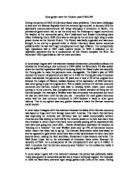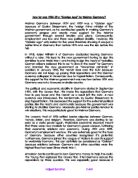Improved foreign relations also helped to contribute to improved domestic affairs. The Treaty of Berlin was established in April 1926. Under this treaty, relations were built upon the Treaty of Rapallo, and Germany provided the USSR with economic expertise in return for Soviet help with rearmament.
Economically, Germany was becoming stronger. Inflation had been cured and the temporary currency, the Rentenmark had been replaced with the Reichsmark, which was backed by gold. There had been five years of continuous growth in production and unemployment remained low. More money was entering Germany through foreign loans (mainly from the USA) than was leaving through reparations. Between 1924 and 1931, Germany received 18,000 million marks in foreign loans and paid out 11,100 million marks in reparations. This investment boosted industrial expansion and social expenditure. In July 1927, the Unemployment Insurance Scheme was introduced. This was a system of welfare which extended on original welfare systems in place. It protected over 17 million workers against unemployment. These measures strengthened support amongst many ordinary Germans. State governments with the help of international loans were able to improve schools, housing, roads and electricity supplies. There was a plethora of foreign loans from the USA, Britain and other countries. The main reason for this was to help the German economy prosper so that Germany could pay reparations to Britain and France, then repay the loans back to the USA.
Further improvements in foreign affairs also helped the political development of Weimar Germany. In 1925, Stresemann signed the Locarno Pact with Britain, France, Belgium and Italy. As part of this, Stresemann accepted Germany’s western borders and was protected against further French invasion, ensuring further political stability. In September 1926, Germany joined the League of Nations. This helped domestic affairs, as Germany used its position to raise matters German interest, such as the issue of German in its lost lands, and links with the USSR strengthened Germany’s bargaining position. Foreign loans totalled 25.5 million marks, with a majority from the USA, strengthening the German government’s position within Germany.
In April 1925, Field Marshal Hindenburg is elected president. This meant that many conservatives were reassured that the republic would protect their interests. Hindenburg also kept his promise that he would uphold the constitution ensuring better political stability.
Despite these positive contributions to economic and political stability, there were underlying problems, threatening the stability of the Weimar government 1924-29. Stresemann’s policy of Erfullingpolitik (fulfilment) was very unpopular. Any payment of reparations, no matter how repackaged, would be resented by most Germans. No party had been able to a majority in the Reichstag, so the Weimar republic was still plagued by weak, short-lived coalition governments. There were six changes of government during 1924-28. Although there was continual industrial growth in Germany, industrial production grew at a far slower rate than in other European countries, and unemployment remained a problem. Germany’s share of world production fell from 14.3% in 1913 to 11.6% in 1926-29. Employers considered their prospects for expansion were hindered by the too powerful trade unions. From 1927, farmers were increasingly hit by falling food prices, and were getting into debt. From 1928 over one-third of farms were running at a loss. Although extremists posed no direct threat, the republic still faced opposition from both left and right wing parties who were biding their time. In the 1928 elections the KPD gained over 10% of the vote; the Nazis made significant gains in northern rural areas. There were some crucial underlying weaknesses in the economy. The fact that more money was entering the economy than leaving it in reparations can be seen as a negative point as well. The German industry and economy, together with its industrial growth and expansion was built purely upon loans, making it highly vulnerable to the world economy, which was later to be a large problem. The government was also struggling with welfare payments introduced under the Unemployment Insurance Scheme in July 1927. Some historians, such as Peukert, argue that Stresemann should have accepted Germany’s eastern borders and concentrated on building up economic and political influence in the new states in eastern and south-eastern Europe.
However, successive German governments were able to maintain a certain degree of stability. This is why this period in time was entitled ‘The Golden Years’. German governments improved both the lives of the working class (by the Unemployment Insurance Scheme) and the middle and upper classes (by bringing foreign investment for businesses). Stresemann’s actions as foreign minister improved foreign affairs through various treaties and pacts, therefore improving domestic affairs. Although Germany was heavily dependent on short-term American loans, it did manage to restore production levels in 1929 to that of 1913. Political calm was restored to Germany and there were no attempts to overthrow the system. Hyperinflation was cured and economic stability was restored with the introduction of the rentenmark, then later the reichsmark. Overall, successive German governments managed to maintain stability throughout 1924-29, yet there were underlying problems which threatened the state.







